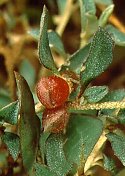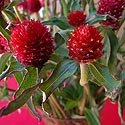|
Family: Amaranthaceae (sugarbeet, spinach family)
[= Chenopodiaceae]
Life
> eukaryotes >
Archaeoplastida >
Chloroplastida
>
Charophyta > Streptophytina > Plantae (land plants)
> Tracheophyta (vascular plants) > Euphyllophyta > Lignophyta (woody plants)
> Spermatophyta (seed plants) > Angiospermae (flowering
plants)
> Core Eudicots
> Order: Caryophyllales
About 174 genera and 2050 species (cosmopolitan) of which
33 genera and 206 species are native to southern Africa, an additional six
genera and 42 species are naturalised, and an additional five genera and 21
species are cultivated in the region.
Genera native to southern Africa
Information mainly from Jordaan (2000a, b).
|
Achyropsis
Six species, native to Africa, with three species
native to southern Africa. |
|
|
Aerva
About 10 species, native to the warmer regions of
Africa and Asia, with three species native to southern Africa. |
|
|
Amaranthus
About 60 species, found worldwide mainly in
warmer regions. Eight species are native to southern Africa, 10 species are
naturalised, and a further species is cultivated in the region. Species of Amaranthus are cultivated and the
leaves cooked like spinach ('morogo'). |
|
|
Arthraerua
One species, Arthraerua
leubnitziae, native to the coast of Namibia. |
|
|
Atriplex
About
250 species, found worldwide, mainly in arid, saline or disturbed habitats
in temperate and tropical regions. There are 12 species native to southern Africa,
five naturalised, and an additional eight species that have been
cultivated in the region. |
 |
|
Bassia
About 10 species,
native to Eurasia and Africa, with four species native to southern Africa.
Found in salt marshes along the coast and along rivers. |
|
|
Calicorema
Two species, endemic to Namibia and South Africa (Northern Cape). |
|
|
Celosia
About 45 species,
native to the warmer regions of the world, with four species native to southern Africa,
one species that is naturalised, and a further two species that are cultivated
in the region. |
|
|
Centema
Two species, native to southern tropical Africa, one of which, Centema subfusca,
occurs in southern Africa. |
|
|
Centemopsis
Three species (tropical Africa), of which one
Centemopsis gracilenta is native to southern Africa, occurring in
Zimbabwe and Mozambique. See
Flora of Zimbabwe. |
|
|
Centrostachys
One species,
Centrostachys aquatica, which has a wide distribution over tropical
Africa and Asia. |
|
|
Chenopodium
About 150 species, found worldwide, with 10 species native to southern Africa, 13
species that are naturalised, and a further two species that are cultivated
in the region. The leaves of
a number of species are cooked and eaten in the same way as spinach. |
|
|
Cyathula
About 25 species,
widespread in the tropics, with eight species native to southern Africa. |
|
|
Exomis
The sole
species, Exomis microphylla, is native to arid areas of southern
Africa. |
|
|
Halopeplis
Three species, native to southern Europe, Western Asia and Africa, with
one
species, Halopeplis amplexicaulis, native to southern Africa,
occurring in
saline habitats on the West Coast. |
|
|
Halosarcia
Twenty-three
species, nearly all endemic to Australia except for one species,
Halosarcia indica, which
has a wide distribution along the shores of the Indian Ocean, including
the coast of Mozambique and KwaZulu-Natal. |
|
|
Hermbstaedtia
About 15 species, native to Africa, with 12 species native
to southern Africa. |
|
|
Kochia
About five species, native to Africa and Eurasia, with two
species native to southern Africa, one species that is naturalised and a further species that is cultivated in
the region. |
|
|
Kyphocarpa
About four species, native to tropical and southern
Africa, three of which occur in southern Africa. |
|
|
Leucosphaera
One species, Leucosphaera
bainesii, native to Angola, Namibia, Botswana and South Africa (Northern Cape). |
|
|
Manochlamys
One
species, Manochlamys albicans, native to Namibia and South
Africa (Northern and Western Cape). |
|
|
Marcelliopsis
Three
species, all endemic to Namibia. |
|
|
Nelsia
Nelsia quadrangula is native to Namibia and Botswana.
The other species in the genus is native to Angola. |
|
|
Nothosaerva
One species, Nothosaerva
brachiata, with a wide distribution covering the Indian subcontinent
and tropical Africa, including Mozambique, the Northern Province and northern
KwaZulu-Natal. |
|
|
Pandiaka
About 12 species, native to tropical Africa, with three
species native to southern Africa. |
|
|
Psilotrichum
About 18
species, native to tropical Africa and Asia, with one species, Psilotrichum
scleranthum (see
Flora of Zimbabwe), native to southern Africa. |
|
|
Pupalia
Four species,
native to the Old World tropics, with two species native to southern
Africa. |
|
|
Salicornia
About 13
species, found nearly worldwide, but not Australia. Four species native to
southern Africa, found along the coast in sheltered, saline conditions. |
|
|
Salsola
About 150 species, native to Europe, Asia and Africa,
where it occurs in arid and semi-arid regions. Eighty-eight species are native
to
southern Africa, and the weed Salsola kali has become naturalised in the
region. |
|
|
Sarcocornia
About 15
species, found nearly worldwide, with 12 species native to southern
Africa, found along the coast. |
|
|
Sericocoma
Three species, endemic to southern Africa. |
|
|
Sericorema
Two species, endemic to southern Africa. |
|
|
Suaeda
About 110 species,
found worldwide but mainly in the northern Hemisphere. Six species are
native to
southern Africa, found in saline conditions both inland and along the
seashore. |
|
Genera naturalised in southern Africa
Information mainly from Jordaan (2000a, b).
|
Achyranthes
About six to eight
species, native to warm temperate and tropical regions of the Old World,
with one species, Achyranthes aspera (Burweed, Chirchita),
naturalised in southern Africa. See Flora of Zimbabwe, where it is split
into
var. pubescens and
var. sicula. |
|
|
Alternanthera
About
100 species, native mainly to the New World tropics and subtropics; four
species have become naturalised in southern Africa and a further two
species are cultivated in the region. |
|
|
Beta
About 12 species,
native mainly in Europe and the Mediterranean. Includes Beta vulgaris (Beetroot,
Sugarbeet, Mangel-wurzel), which has become established as an escape
from cultivation in southern Africa, mainly in the Western Cape. |
 |
|
Einadia
Six species,
native to Australia and New Zealand. Einadia nutans has become
naturalised in southern Africa. |
|
|
Gomphrena
About 120
species, native mainly to the New World tropics and subtropics and also
Australia; three species have become naturalised as weeds in southern Africa. |
 |
|
Guilleminea
Five
species, native to the Americas; one species, Guilleminea densa,
has become naturalised as a weed in southern Africa. See
Flora of Zimbabwe. |
|
Other species, cultivated in southern Africa
List from Glen (2002).
Bosea amherstiana
Native to Pakistan. |
|
Einadia nutans (Climbing saltbush)
Native to Australia. |
|
Maireana
About 57 species, endemic to Australia. Three species are
cultivated in southern Africa. |
|
Rhagodia parabolica
Native to Australia. |
|
|
Spinacea oleracea
(Spinach)
Spinacea oleracea appears to have been selectively
cultivated from Spinacea tetrandra which is native to the mountainous
regions of southwestern Asia (the Himalayas and Afghanistan). The first known
record of using Spinach as a vegetable dates back to China in the 7th to 8th
centuries AD and the first record of its use in Europe dates to the
1200's. |
|
Publications
-
Brenan, J.P.M. 1988. Chenopodiaceae. Flora Zambesiaca
9,1: 133-161.
-
Glen, H.F. 2002. Cultivated Plants of
Southern Africa. Jacana, Johannesburg.
-
Jordaan, M. 2000a. Amaranthaceae. In: Seed Plants of
Southern Africa (ed. O.A. Leistner). Strelitzia 10: 49-56.
National Botanical Institute, Pretoria.
-
Jordaan, M. 2000b. Chenopodiaceae. In: Seed Plants of
Southern Africa (ed. O.A. Leistner). Strelitzia 10: 221-226.
National Botanical Institute, Pretoria.
Text by Hamish Robertson |
